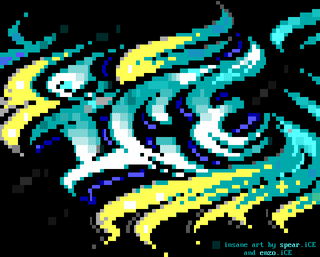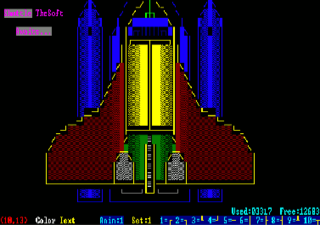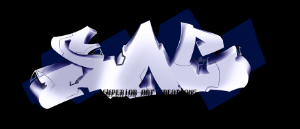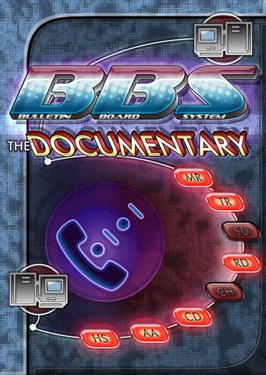Related Research Articles

ASCII art is a graphic design technique that uses computers for presentation and consists of pictures pieced together from the 95 printable characters defined by the ASCII Standard from 1963 and ASCII compliant character sets with proprietary extended characters. The term is also loosely used to refer to text-based visual art in general. ASCII art can be created with any text editor, and is often used with free-form languages. Most examples of ASCII art require a fixed-width font such as Courier for presentation.

A bulletin board system (BBS), also called a computer bulletin board service (CBBS), is a computer server running software that allows users to connect to the system using a terminal program. Once logged in, the user performs functions such as uploading and downloading software and data, reading news and bulletins, and exchanging messages with other users through public message boards and sometimes via direct chatting. In the early 1980s, message networks such as FidoNet were developed to provide services such as NetMail, which is similar to internet-based email.
The computer art scene, or simply artscene, is the community interested and active in the creation of computer-based artwork.

.nfo is a filename extension for text files that accompany warez scene releases of pirated software or media.
An acid is any chemical compound that, when dissolved in water, gives a solution with a pH of less than 7.0.
Christian Wirth, better known by the pseudonym RaD Man, is an American computer artist and historian. He works in the field of ANSI art, a method of creating art using a limited set of text characters and color escape codes based loosely on the relevant ANSI standard.

FILE_ID.DIZ is a plain-text file containing a brief description of the content of the archive to which it belongs. Such files were originally used in archives distributed through bulletin board systems (BBSes) and is still used in the warez scene. FILE_ID stands for "file identification". DIZ stands for "description in zipfile".
ANSI art is a computer art form that was widely used at one time on bulletin board systems. It is similar to ASCII art, but constructed from a larger set of 256 letters, numbers, and symbols — all codes found in IBM code page 437, often referred to as extended ASCII and used in MS-DOS and Unix environments. ANSI art also contains special ANSI escape sequences that color text with the 16 foreground and 8 background colours offered by ANSI.SYS, an MS-DOS device driver loosely based upon the ANSI X3.64 standard for text terminals. Some ANSI artists take advantage of the cursor control sequences within ANSI X3.64 in order to create animations, commonly referred to as ANSImations. ANSI art and text files which incorporate ANSI codes carry the de facto.ANS file extension.
An artpack is an archive of computer artwork which is distributed in a compressed format such as ZIP or RAR.

iCE Advertisements is a digital art group founded in Canada by Many Axe in 1991. Although the expanded title is rarely ever used, iCE is an acronym for Insane Creators Enterprise. iCE, along with ACiD Productions, was one of the most prominent and critically successful groups on the underground computer artscene.

TheDraw is a text editor for MS-DOS to create ANSI and animations as well as ASCII art. The editor is especially useful to create or modify files in ANSI format and text documents, which use the graphical characters of the IBM ASCII code pages, because they are not supported by Microsoft Windows anymore. The first version of the editor was developed in 1986 by Ian E. Davis of TheSoft Programming Services. The last public version of the editor was version 4.63, which was released in October 1993.

Superior Art Creations (SAC) is an underground artscene group which caters primarily to and is well known within the warez scene. SAC members have made, besides ANSI and ASCII art, VGA bitmap graphics, tracker music, and a variety of other works. SAC's character graphics have also been used in bottles and FTP servers.
Mystic BBS is a bulletin board system software program that began in 1995 and was first released to the public in December 1997 for MS-DOS. It has been ported to Microsoft Windows, OS/2, OS X, and Linux. Mystic was designed to be a spiritual successor to the Renegade (BBS) and Telegard bulletin board systems.

BBS: The Documentary is a 3-disc, 8-episode documentary about the subculture born from the creation of the bulletin board system (BBS) filmed by computer historian Jason Scott of textfiles.com.

Creators of Intense Art, or Cia was an underground computer artscene group that primarily released ANSI, ASCII, and high resolution artwork from 1993 to 2001. Along with iCE and ACiD, Cia was one of the most active, and longest lasting groups on the artscene.
Blade, also referred to as The Blade Nation, was an underground computer artscene group that primarily released ANSI, ASCII, and high resolution artwork from 1994 to 1997, and during a brief time in 1998.

Fire, later known as Fire Graphics, is an underground computer artscene group that released ANSI, ASCII, and high resolution artwork from 1994 to 1998, and from 2021 onwards.
This is a list of the minor computer underground artscene groups spanning from roughly 1992 to the present day.

textfiles.com is a website dedicated to preserving the digital documents that contain the history of the bulletin board system (BBS) world and various subcultures, and thus providing "a glimpse into the history of writers and artists bound by the 128 characters that the American Standard Code for Information Interchange (ASCII) allowed them". The site categorizes and stores thousands of text files, primarily from the 1980s, but also contains some older files and some that were created well into the 1990s. A broad range of topics is presented, including anarchy, art, carding, computers, drugs, ezines, freemasonry, computer games, hacking, phreaking, politics, computer piracy, sex, and UFOs. The site was created and is run by Jason Scott.
Aces of ANSI Art was the first group of artists specifically organized for the purposes of creating and distributing ANSI art. The group was founded and operated by two BBS enthusiasts from California, "Zyphril" and "Chips Ahoy", from 1989 through 1991.
References
- ↑ Garrett, Ben (2004-04-27). "Online Software Piracy of the Last Millennium". defacto2.net.
ACID (ANSI Creators In Demand) where the first of these international groups, trend setters who originally specialised in ANSI art and ANSIMation ads. They earned their reputation at being one of the best groups by creating art for the best pirate boards of the time.
- ↑ Hargadon, Michael A. "Like City Lights, Receding: ANSi Artwork and the Digital Underground, 1985-2000." Concordia University, 2011-03-18. Retrieved 2011-10-18.
- ↑ "Artscene". BBS: The Documentary . 2005.
- ↑ ACiD-100 All-time memberlist (1990–2003)
- ↑ "dark+domain: the artpacks.acid.org collection". cd.textfiles.com.
- ↑ "Dark Domain - Defacto2". defacto2.net. Archived from the original on 2016-03-04.
- ↑ "ACiD sponsors ansi/ascii compo - News". www.demoparty.net.
- ↑ "EVOKE 2005 - partners". www.evoke.eu.
- ↑ "TMDC11 - Text Mode Demo Contest XI". 2008-07-23. Archived from the original on 2008-07-23.
- ↑ "ANSI Art for the Masses video - CNET TV". Archived from the original on 2013-12-15. Retrieved 2013-12-15.
- ↑ "Watch ANSI Art | Geek Entertainment TV Episodes | Tech & Gadgets Videos | Blip". Archived from the original on 2013-12-15. Retrieved 2013-12-15.
- ↑ "ansi". 2008-02-21. Archived from the original on 2008-02-21.
- ↑ Lee, Ellen (2008-01-12). "Early computer-generated art revived for S.F. exhibit". SFGate.
- ↑ "Deeply psychedelic ANSI scroller is longest ever". Boing Boing. 2013-10-10. Archived from the original on 2015-03-12.
- ↑ Souppouris, Aaron (2013-10-11). "Join R2-D2 and Hitler on an unforgettable ANSI acid trip". The Verge.
- ↑ "Blocktronics ACiD Trip, A Super Long Piece of Collaborative ANSI Art". 2013-10-10.
- ↑ "The Blocktronics ACiD Trip". Acclaim Magazine. 2013-10-13.
- ↑ "Out of sight out of mind by ANSI Creators in Demand". www.pouet.net.